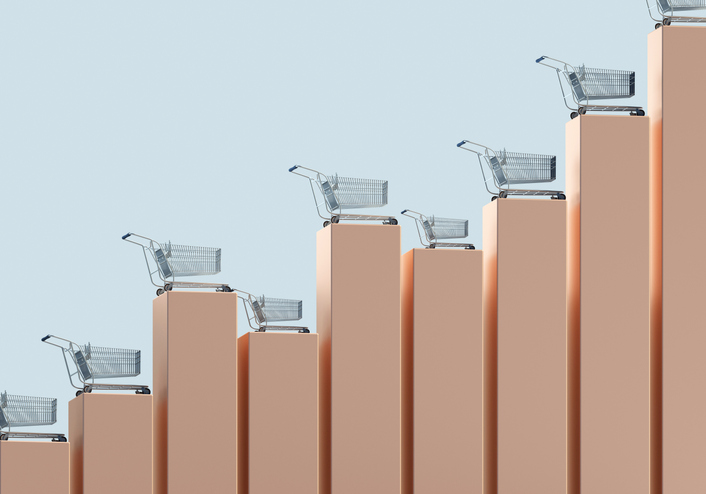Why Is Inflation So Sticky? It Could Be Corporate Profits
Some companies might have been raising prices faster than their costs have increased
Inflation has proved more stubborn than central banks bargained for when prices started surging two years ago. Now some economists think they know why: Businesses are using a rare opportunity to boost their profit margins.
Figures released Tuesday by the European Union’s statistics agency showed consumer prices in the eurozone were 7.0% higher than a year earlier in April, a pickup from March and more than three times the European Central Bank’s target. However, the core rate of inflation—which excludes food and energy prices—edged down to 5.6% in April from a record high of 5.7% in March.
Inflation rates also remain uncomfortably high in the U.S. and many other parts of the world despite interest-rate rises that have gone further and been delivered more quickly than at any time since the 1980s.
There have been good reasons for businesses to raise their prices in recent months. The supply-chain disruptions caused by the Covid-19 pandemic and the energy, food and raw-material bottlenecks that followed Russia’s invasion of Ukraine have pushed costs higher.
But there are signs that companies are doing more than covering their costs.
According to economists at the ECB, businesses have been padding their profits. That, they said, was a bigger factor in fuelling inflation during the second half of last year than rising wages were.
Jan Philipp Jenisch, chief executive of construction-materials maker Holcim, said on a recent earnings call: “We are in that inflationary environment already for almost two years now…We have done the pricing in a very proactive way, so that our results aren’t suffering. On the contrary, they are improving the margins.”
One puzzle is why consumers have played ball. Usually, economists would expect any business that raised its prices to lose customers to competitors that don’t, or not by as much.
But these aren’t normal times. In rare situations—such as an economy’s reopening after a pandemic—widespread knowledge that costs are rising allows businesses to raise their prices knowing that their competitors will act in the same way, according to a paper by Isabella Weber, assistant professor of economics at the University of Massachusetts, Amherst, and her colleague, Evan Wasner.
That is a pattern the two economists said has played out in an analysis of recent earning calls in which executives at U.S. businesses present their financial results to analysts.
“We do have to think about pricing differently,” said Ms. Weber. “A cost shock, or bottlenecks can create an implicit agreement among firms that raise their prices, so they can expect others to act likewise.”
Consumers have also been unusually willing to accept higher prices lately. Paul Donovan, chief economist at UBS Global Wealth Management, said businesses are betting that consumers will go along because they know about supply bottlenecks and higher energy prices.
“They are confident that they can convince consumers that it isn’t their fault, and it won’t damage their brand,” Mr. Donovan said.
The latest round of earning calls by large consumer-facing companies underlined that. Food and health company Nestlé last week said it had boosted sales by 5.6% in the first three months of the year despite raising its prices by 9.8%—its CEO said the company was simply matching cost increases over the previous two years.
“We’re still in the process of catching up with some of the hits we’ve taken,” said Mark Schneider in a call with analysts.
Elsewhere, the desire to boost margins, rather than just cover increased costs, appears to be one reason why food prices have continued to rise rapidly in Europe.
Much of the surge in food prices since the middle of last year stems from higher costs, particularly for energy, since most food production is quite energy-intensive. But economists at insurance company Allianz have calculated that about 10% of the rise reflects the search for higher profits. They suggest that is possible because key parts of the food-supply chain are dominated by a small number of firms.
“There is not enough competition in the food sector, especially in distribution,” said Ludovic Subran, chief economist at Allianz.
Not all businesses are opportunistically boosting their margins and Ms. Weber said that when some do, it can cause problems for others that are closer to the final consumer and are at greatest risk of facing a backlash.
Over recent months, Germany’s largest retailer, Edeka, has complained about the pricing behaviour of its suppliers of branded goods and has stopped stocking some of their products.
“We call on the branded-products industry to live up to its responsibility and stop artificially driving up inflation,” said Edeka’s CEO Markus Mosa.
There are some signs that food-price inflation is starting to slow. In France, food prices were 14.9% higher in April than a year earlier, a slowdown from 15.9% in March. In Germany, food inflation slowed to 17.2% from 22.3%. But the British Retail Consortium, a group that represents U.K. stores, said food inflation accelerated in April to hit a record high.
In recent earnings calls, some executives said consumers were becoming more resistant to price rises.
“We will probably see pricing moving down,” said Francois-Xavier Roger, Nestlé’s chief financial officer.
Last month, Procter & Gamble said it had boosted its profit margins in the first three months of the year, thanks in large part to higher prices. It warned that there were limits to how far it could push that tactic before consumers switched to cheaper alternatives.
“We’ve made several adjustments to price gaps, not just versus private label, but versus branded competition as we’ve gone through this period of pricing, and we need to continue to be sensitive to that,” said Jon Moeller, the company’s CEO.
For Mr. Donovan at UBS, the period of profit-driven inflation might be coming to an end, in part because of rising public scrutiny.
“We are probably at a point where companies may be reassessing whether to push this,” he said. “A reputation for being poor value for money stays for a long time.”
 Copyright 2020, Dow Jones & Company, Inc. All Rights Reserved Worldwide. LEARN MORE
Copyright 2020, Dow Jones & Company, Inc. All Rights Reserved Worldwide. LEARN MORE
This stylish family home combines a classic palette and finishes with a flexible floorplan
Just 55 minutes from Sydney, make this your creative getaway located in the majestic Hawkesbury region.
Impact investing is becoming more mainstream as larger, institutional asset owners drive more money into the sector, according to the nonprofit Global Impact Investing Network in New York.
In the GIIN’s State of the Market 2024 report, published late last month, researchers found that assets allocated to impact-investing strategies by repeat survey responders grew by a compound annual growth rate (CAGR) of 14% over the last five years.
These 71 responders to both the 2019 and 2024 surveys saw their total impact assets under management grow to US$249 billion this year from US$129 billion five years ago.
Medium- and large-size investors were largely responsible for the strong impact returns: Medium-size investors posted a median CAGR of 11% a year over the five-year period, and large-size investors posted a median CAGR of 14% a year.
Interestingly, the CAGR of assets held by small investors dropped by a median of 14% a year.
“When we drill down behind the compound annual growth of the assets that are being allocated to impact investing, it’s largely those larger investors that are actually driving it,” says Dean Hand, the GIIN’s chief research officer.
Overall, the GIIN surveyed 305 investors with a combined US$490 billion under management from 39 countries. Nearly three-quarters of the responders were investment managers, while 10% were foundations, and 3% were family offices. Development finance institutions, institutional asset owners, and companies represented most of the rest.
The majority of impact strategies are executed through private-equity, but public debt and equity have been the fastest-growing asset classes over the past five years, the report said. Public debt is growing at a CAGR of 32%, and public equity is growing at a CAGR of 19%. That compares to a CAGR of 17% for private equity and 7% for private debt.
According to the GIIN, the rise in public impact assets is being driven by larger investors, likely institutions.
Private equity has traditionally served as an ideal way to execute impact strategies, as it allows investors to select vehicles specifically designed to create a positive social or environmental impact by, for example, providing loans to smallholder farmers in Africa or by supporting fledging renewable energy technologies.
Future Returns: Preqin expects managers to rely on family offices, private banks, and individual investors for growth in the next six years
But today, institutional investors are looking across their portfolios—encompassing both private and public assets—to achieve their impact goals.
“Institutional asset owners are saying, ‘In the interests of our ultimate beneficiaries, we probably need to start driving these strategies across our assets,’” Hand says. Instead of carving out a dedicated impact strategy, these investors are taking “a holistic portfolio approach.”
An institutional manager may want to address issues such as climate change, healthcare costs, and local economic growth so it can support a better quality of life for its beneficiaries.
To achieve these goals, the manager could invest across a range of private debt, private equity, and real estate.
But the public markets offer opportunities, too. Using public debt, a manager could, for example, invest in green bonds, regional bank bonds, or healthcare social bonds. In public equity, it could invest in green-power storage technologies, minority-focused real-estate trusts, and in pharmaceutical and medical-care company stocks with the aim of influencing them to lower the costs of care, according to an example the GIIN lays out in a separate report on institutional strategies.
Influencing companies to act in the best interests of society and the environment is increasingly being done through such shareholder advocacy, either directly through ownership in individual stocks or through fund vehicles.
“They’re trying to move their portfolio companies to actually solving some of the challenges that exist,” Hand says.
Although the rate of growth in public strategies for impact is brisk, among survey respondents investments in public debt totaled only 12% of assets and just 7% in public equity. Private equity, however, grabs 43% of these investors’ assets.
Within private equity, Hand also discerns more evidence of maturity in the impact sector. That’s because more impact-oriented asset owners invest in mature and growth-stage companies, which are favored by larger asset owners that have more substantial assets to put to work.
The GIIN State of the Market report also found that impact asset owners are largely happy with both the financial performance and impact results of their holdings.
About three-quarters of those surveyed were seeking risk-adjusted, market-rate returns, although foundations were an exception as 68% sought below-market returns, the report said. Overall, 86% reported their investments were performing in line or above their expectations—even when their targets were not met—and 90% said the same for their impact returns.
Private-equity posted the strongest results, returning 17% on average, although that was less than the 19% targeted return. By contrast, public equity returned 11%, above a 10% target.
The fact some asset classes over performed and others underperformed, shows that “normal economic forces are at play in the market,” Hand says.
Although investors are satisfied with their impact performance, they are still dealing with a fragmented approach for measuring it, the report said. “Despite this, over two-thirds of investors are incorporating impact criteria into their investment governance documents, signalling a significant shift toward formalising impact considerations in decision-making processes,” it said.
Also, more investors are getting third-party verification of their results, which strengthens their accountability in the market.
“The satisfaction with performance is nice to see,” Hand says. “But we do need to see more about what’s happening in terms of investors being able to actually track both the impact performance in real terms as well as the financial performance in real terms.”
This stylish family home combines a classic palette and finishes with a flexible floorplan
Just 55 minutes from Sydney, make this your creative getaway located in the majestic Hawkesbury region.






















